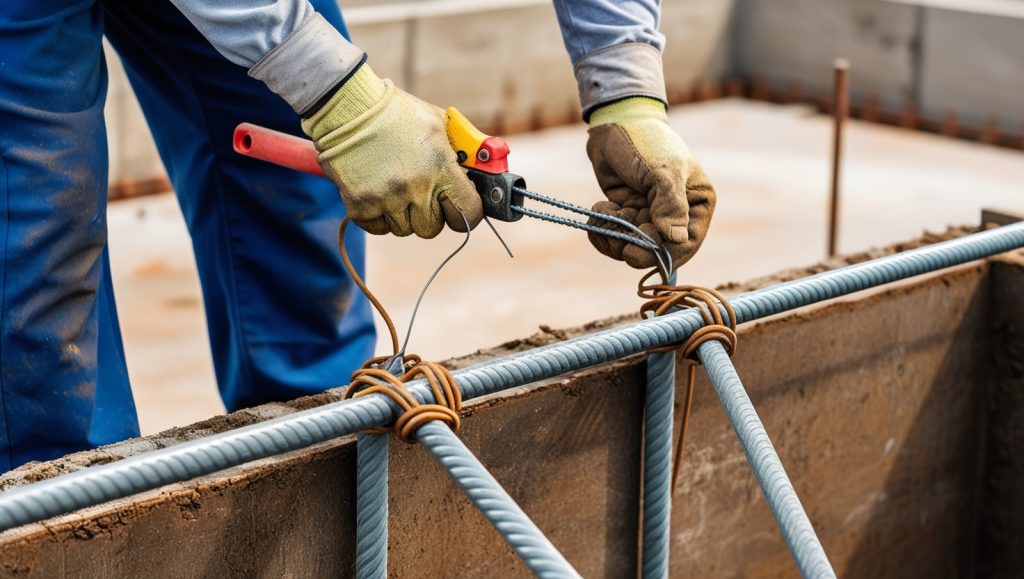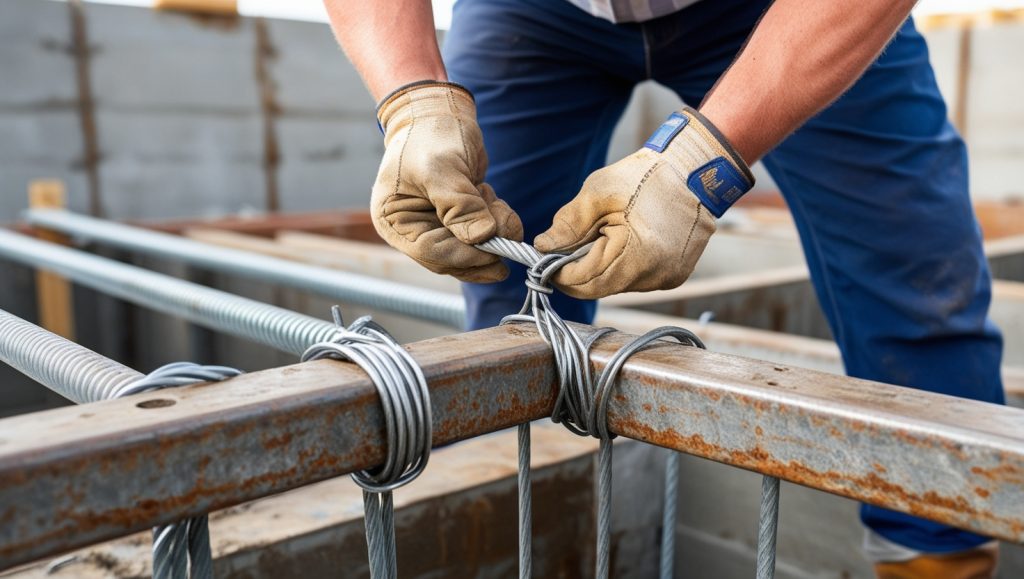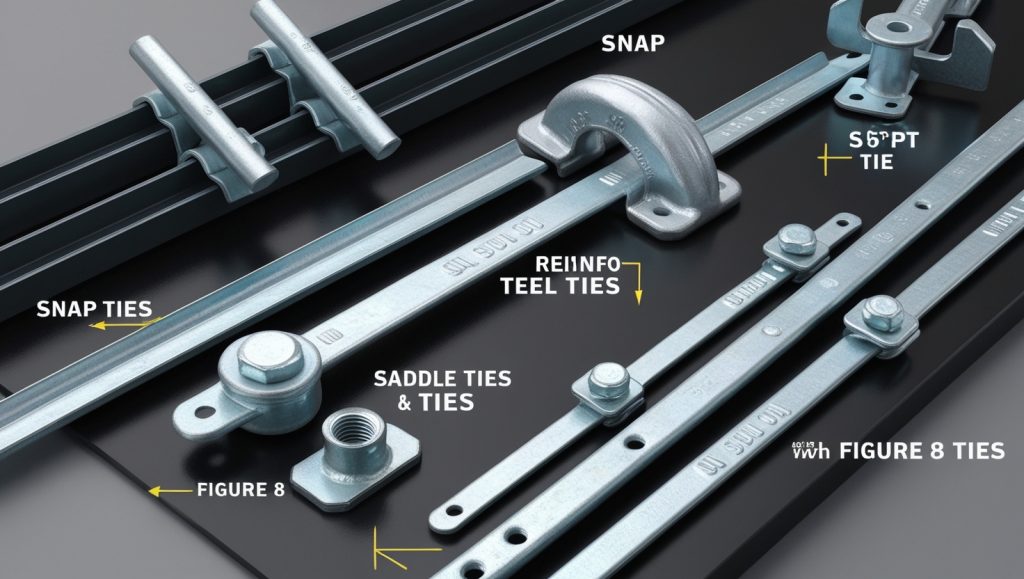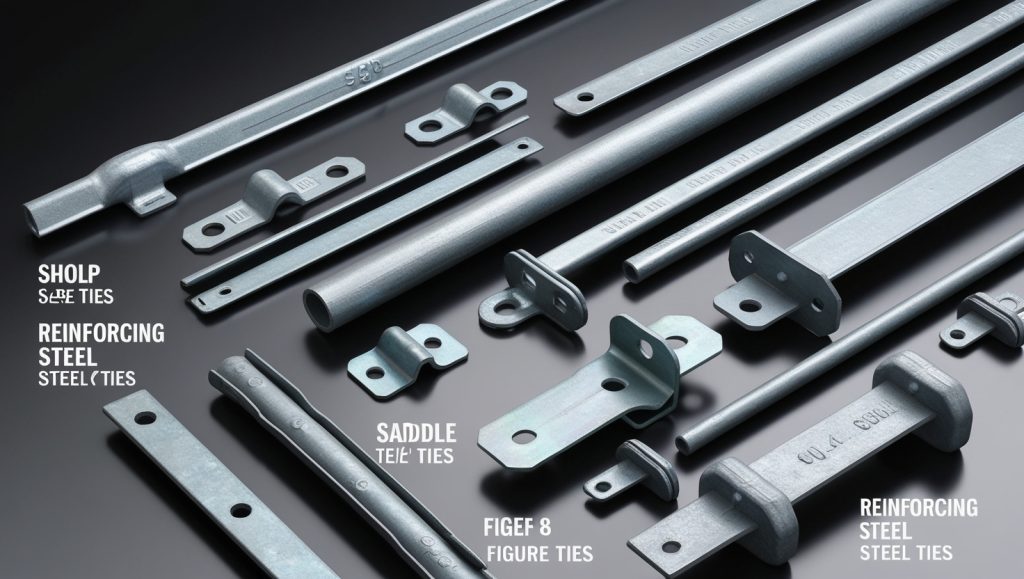Have you ever thought about how big buildings, bridges, and roads stay strong for a long time? It’s not just the concrete that makes them strong—there’s also something hidden inside called reinforcing steel, or “rebar.” Rebar is a type of strong metal that helps the concrete stay in place and not crack. Without rebar, concrete can break over time, especially if the building or road has to hold a lot of weight, like cars or people walking on it.
To make sure the rebar stays in the right spot, construction workers tie the rebar together using strong wire. This keeps the steel bars from moving when they pour the concrete over them. If the rebar moves, the concrete can get weak and break, which would make the building or bridge unsafe. That’s why tying the rebar is so important.

There are different ways to tie the rebar, depending on how strong the building needs to be. Some ties are fast and easy, while others take more time but make the structure much stronger. By tying rebar properly, construction workers make sure the concrete stays strong and can hold up buildings, bridges, and roads for many years. This helps keep everyone safe.
What is Reinforcing Steel?
Reinforcing steel is a strong metal that we put inside concrete to make it stronger. Concrete alone is tough, but it can crack or break when put under a lot of pressure. That’s why construction workers use rebar. Workers place steel bars in a grid pattern to hold the concrete together and make it much stronger.
Think of it like building with Legos. If you just stack the blocks, they could fall over. But if you use something strong inside to hold them together, like glue, the structure becomes much sturdier. Reinforcing steel works like the glue that makes concrete super strong.
Why is Tying Reinforcing Steel Important?
Tying reinforcing steel is what keeps the steel bars in the right position while workers pour the concrete. When workers tie the steel correctly, it stays still, and the concrete can settle around it perfectly. If the steel moves even a little bit, the building or structure could become weaker and might not last as long.
Imagine tying your shoelaces. If you tie them loosely, your shoes might fall off, and you could trip. But if you tie them tightly, your shoes will stay on, and you can run and play without worrying. In the same way, tying the rebar properly helps the concrete structure stay strong and safe.
The Process of Tying Reinforcing Steel
The process of tying reinforcing steel takes time and practice, but it’s an important part of construction. This is how workers tie the steel:
Positioning the Rebar
First, workers position the steel bars in a pattern. These bars often look like a grid, with some bars going across and others going up and down.
Using Tying Wire
Next, workers use thin, strong wire to tie the steel bars together. The wire acts like the string in a friendship bracelet, keeping everything connected.

Tying the Knot
Workers twist the wire around the bars where they meet, making sure the bars stay tightly in place. There are different types of knots they use, but all of them help hold the bars firmly.
Double-Checking the Ties
It’s important to check the knots to make sure they’re tight. If workers don’t twist the wire properly, the steel can move when they pour the concrete, making the structure weaker.
Types of Ties in Reinforcing Steel
There are different ways to tie reinforcing steel depending on what the structure needs. Each tie has a special purpose, just like there are different ways to tie your shoelaces. Some ties are strong but quick, while others take more time but provide extra strength.
Snap Tie
The Snap Tie is like a fast and easy way to tie steel bars. Workers twist the wire around the steel bars a few times. This tie is good for areas where the steel doesn’t need to be super strong. It helps keep the steel in place, but it doesn’t take a long time to do.
Saddle Tie
The Saddle Tie is a stronger way to tie the steel bars. The worker wraps the wire all the way around the steel bars so they don’t move from side to side. Workers use this tie in places where the building needs to be stronger. It helps make sure the steel stays exactly where it should be.
Figure 8 Tie
The Figure 8 Tie looks like the number 8. It’s one of the strongest ties. Workers use this tie in parts of the building that need a lot of strength, like the corners or areas that hold heavy things. This tie helps make sure the building won’t crack or fall apart.
Tools for Tying Reinforcing Steel
Tying reinforcing steel is tough work, but construction workers have special tools to make it easier. The most common tool they use is called a rebar tying tool. This tool helps workers twist the wire around the steel bars quickly and tightly, which makes sure the bars stay in place. Workers also use pliers to grab the wire and twist it the right way so that it holds the steel together firmly.
For really big construction jobs, workers use automatic tools. These tools twist the wire by themselves, so workers don’t have to do it by hand. The automatic tools are faster, which helps workers save time when working on large projects like tall buildings or long bridges.
Whether workers use hand tools or automatic ones, their goal is always the same—to keep the steel bars tied tightly together. This keeps the concrete strong and makes sure the structure is safe.
What Happens After Tying the Reinforcing Steel?
After workers finish tying the rebar and double-checking their work, they pour the concrete. The concrete is a liquid when it’s first mixed, so it flows easily over the rebar and fills all the gaps around it. As the concrete is poured, it surrounds the steel bars completely. This step is crucial because the concrete needs to cover every part of the rebar to make the structure strong.

Once the concrete is poured, it starts to harden over the next few days. As it dries, it becomes solid and strong. The rebar inside the concrete acts like a support system. It helps hold the concrete together and prevents it from cracking or breaking. Without the rebar, the concrete would be weaker and might crack more easily.
To understand this better, think about baking a cake. When you mix the batter, it’s soft and wobbly. But when you bake it in the oven, it turns solid and stays in shape. The rebar is like the ingredients in the cake. Without these ingredients, the cake might crumble, but with them, the cake stays firm and delicious. In the same way, the rebar helps the concrete stay strong and keeps buildings, bridges, and roads safe and sturdy for many years.
Mistakes to Avoid When Tying Reinforcing Steel
Tying reinforcing steel might seem easy, but there are some common mistakes that can happen if workers aren’t careful. Here are a few things to watch out for:
Loose Ties
If the workers don’t tie the wire tightly, the steel bars can shift when they pour the concrete. This could make the structure weaker.
Using the Wrong Type of Tie
Each type of tie has a purpose, and using the wrong one could lead to problems. For example, using a quick snap tie in a high-pressure area might not provide enough strength.
Skipping the Double Check
Always check the ties! Even if the tie looks good, a quick check makes sure everything is safe before pouring the concrete.
Importance of Tying Reinforcing Steel in Different Projects
Tying reinforcing steel isn’t just important for big buildings. Workers also use rebar in projects like:
Bridges
Rebar helps bridges hold the weight of cars, trucks, and people. Without strong rebar ties, a bridge could crack or even collapse over time.
Sidewalks and Driveways
Rebar stops concrete from cracking when cars drive over it or people walk on it, even in small projects.
Skyscrapers
Tall buildings need strong foundations, and reinforcing steel is a big part of that. The taller the building, the more rebar workers use to keep it standing tall.
What You Can Learn from Tying Reinforcing Steel
Even though tying rebar is a special job for construction workers, we can learn some important lessons from it that apply to our own lives. When workers tie the rebar, they have to be very careful and make sure everything is done right. They don’t rush through the job because if they do, they might make mistakes, and the building could become weak or unsafe.

This teaches us that being careful and paying attention to details is important in everything we do. Whether you are doing your homework, helping with chores, or working on a project, it’s better to take your time and check your work. Rushing can lead to mistakes, but by working carefully and making sure everything is done properly, you can do a great job and be proud of your work.
So, next time you have a task to do, remember how workers tie rebar with care. It’s a good reminder to focus on what you’re doing, check your work, and take your time to do it right. This way, you can achieve your goals and do your best in everything you try.
If you want to check Thickness for concrete slab, Click here
Conclusion
Tying reinforcing steel is an essential part of building structures that last a long time. From sidewalks to skyscrapers, rebar helps keep concrete strong and secure. By learning about different ties, tools, and double-checking, we can see how important it is to keep our world safe while building. Next time you pass a construction site, remember that there’s more to those buildings than meets the eye. The reinforcing steel inside is working hard to keep everything standing tall.
FAQs
Reinforcing steel, also known as “rebar,” is a type of strong metal that is used in construction. It is placed inside concrete to make the concrete stronger and stop it from cracking.
We need to tie reinforcing steel to keep the steel bars in place while the concrete is poured. This makes sure that the building or structure is strong and doesn’t fall apart.
Workers use special wire to twist around the steel bars where they meet. This wire acts like a knot that holds the bars together so they don’t move when the concrete is poured.
If the steel isn’t tied properly, it can move when the concrete is poured. This can make the building or structure weak and unsafe.
Workers use tools like rebar tying tools and pliers to twist the wire tightly around the steel bars. These tools help them tie the steel quickly and securely.
There are different types of ties, like the snap tie, saddle tie, and figure 8 tie. Each tie has a different way of wrapping the wire around the steel bars to keep them in place.
Concrete is a material used to build things like buildings and sidewalks. It’s strong but can crack under pressure. Reinforcing steel helps stop the concrete from cracking and makes it much stronger.
Reinforcing steel is used in many construction projects like buildings, bridges, sidewalks, and driveways. It helps make sure these structures stay strong and don’t break.
The time it takes to tie reinforcing steel depends on the size of the project. Small projects can take a few hours, while big buildings may take days or weeks to finish tying all the steel.
Yes! With the right tools and training, anyone can learn to tie reinforcing steel. It’s a skill that takes practice, but it’s important for keeping buildings and other structures safe.
